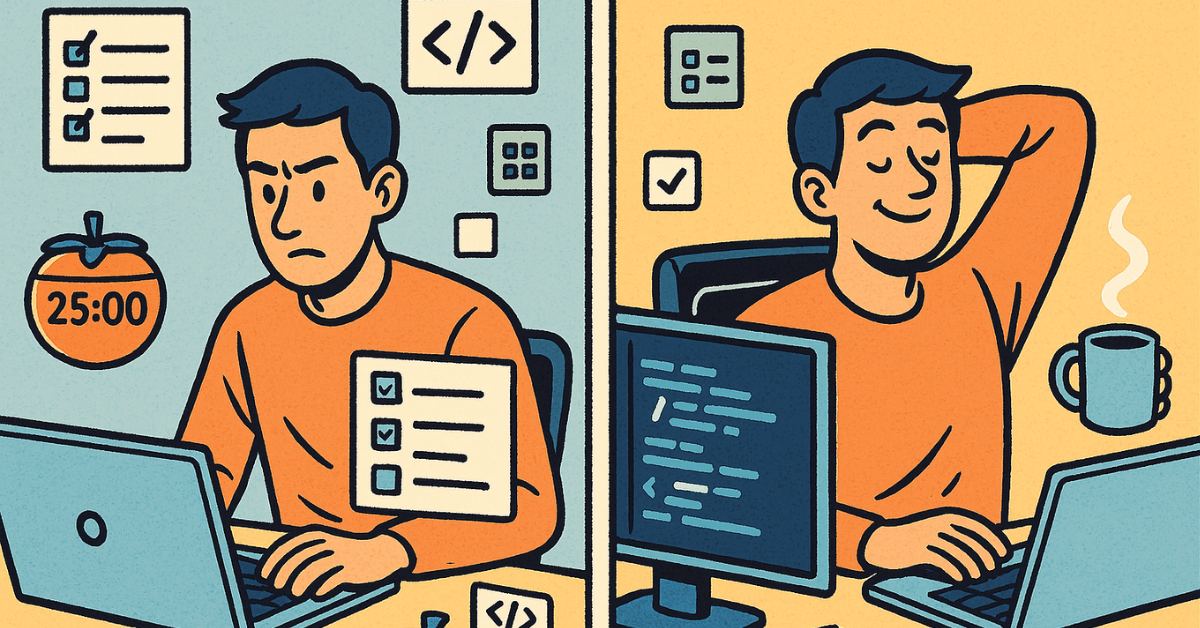As developers, we often pride ourselves on deep focus, those flow-state coding sessions where time disappears. But let’s face it—distractions are everywhere. A quick email check turns into a scroll through socials. A minor bug fix leads to hours of tweaking. Before you know it, half the day’s gone and your to-do list hasn’t budged.
Table of Contents
That’s where the Pomodoro Technique comes in. It’s not a new concept, but in the world of software development—where cognitive load is high and attention is gold—it’s a game-changer. Let’s break it down and see how time-blocking can genuinely make you a better, more efficient coder.
What Is the Pomodoro Technique?
Developed in the late 1980s by Francesco Cirillo, the Pomodoro Technique is a simple time management method. The basic idea? You work in focused bursts of 25 minutes (called a “Pomodoro”), followed by a 5-minute break. After four cycles, you take a longer 15–30 minute break.
This rhythm helps your brain stay sharp, avoids burnout, and actually makes your working hours feel more manageable.
Why It Works for Developers
Coding requires serious mental energy. It’s creative, logical, problem-solving work—and your brain wasn’t built to handle endless hours without rest. The Pomodoro Technique taps into the psychology of attention spans. Here’s how it helps:
- Reduces cognitive fatigue: Regular breaks give your brain time to recharge.
- Improves task estimation: Each Pomodoro becomes a mini-deadline, helping you gauge how long a task might take.
- Minimizes context-switching: You’re less likely to bounce between tasks when you’ve committed to focusing for just 25 minutes.
- Increases output: Focused time blocks often lead to cleaner, faster code—and fewer mistakes.
How to Start Using Pomodoro as a Developer
Getting started is easy, and you don’t need any fancy tools. Here’s the basic routine:
- Pick a task: Maybe you’re building a feature, debugging, or writing documentation.
- Set a timer for 25 minutes: Use your phone, a browser extension, or a tool like Pomofocus.
- Work on the task until the timer rings: No distractions, no context switches—just commit.
- Take a 5-minute break: Stretch, breathe, grab some water.
- After four Pomodoros, take a longer break: Go for a walk, have a snack, and reset.
Pro tip: Pair this technique with the “2-Minute Rule” from David Allen’s GTD method. If something pops into your head and it takes under 2 minutes to do, knock it out during your break. Otherwise, jot it down and revisit after your Pomodoro.
Tools That Help You Pomodoro Like a Pro
There are dozens of tools to keep you on track. A few developer-favorites include:
- Pomotodo: Combines Pomodoro with task tracking.
- Focus To-Do: Simple and cross-platform.
- Toggl Track: Great for time-tracking + Pomodoro-style workflows.
- Tomato Timer: Lightweight and browser-based—no signup needed.
Or keep it analog with a good old-fashioned kitchen timer. The method matters more than the tool.
Real-World Use: Dev Teams & Pomodoro
Many agile teams are adopting Pomodoro sessions as part of their sprints. Some even run “team Pomodoros,” where everyone codes for 25 minutes, then shares updates during the breaks. It keeps communication tight and energy high.
Freelancers and solo devs love it too—it turns an overwhelming workday into bite-sized wins.
What to Watch Out For
Like any productivity method, Pomodoro isn’t perfect. Some tasks, like debugging a complex issue, may need more than 25 minutes of uninterrupted time. The key is flexibility. Use Pomodoro as a guide, not a rigid rulebook.
Also, don’t skip your breaks. They’re the secret weapon. That short pause might be the moment your brain finally cracks the logic bug you’ve been stuck on.
Final Thoughts: Make Time Your Ally
At its heart, the Pomodoro Technique is about respecting your time—and your brain. As a developer, your work is creative and mentally intense. You owe it to yourself to build better habits that support long-term success.
So next time you sit down to code, try blocking out a Pomodoro or two. You might be surprised how much you get done—and how good it feels to hit your goals without feeling burnt out.





